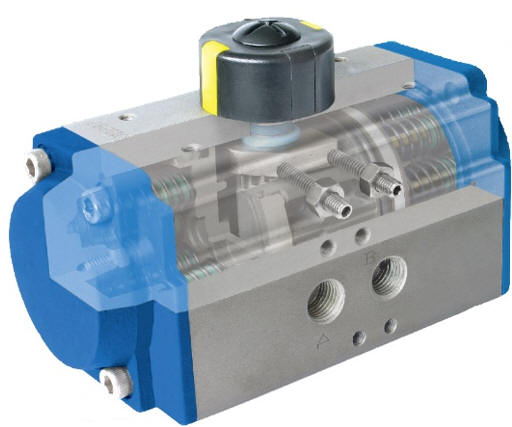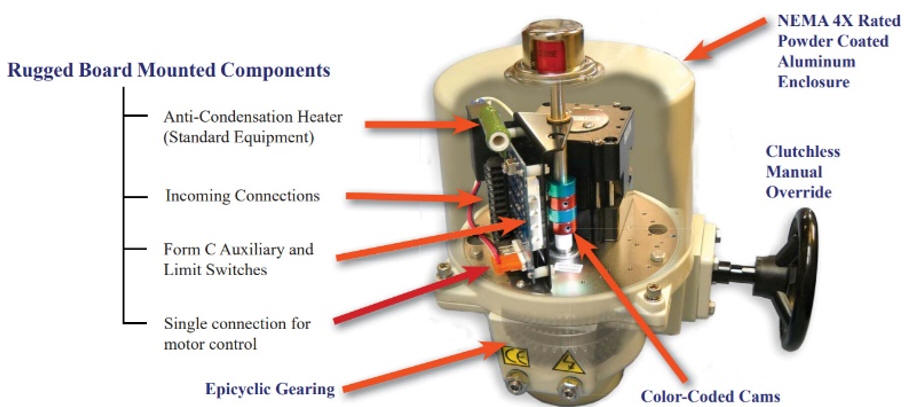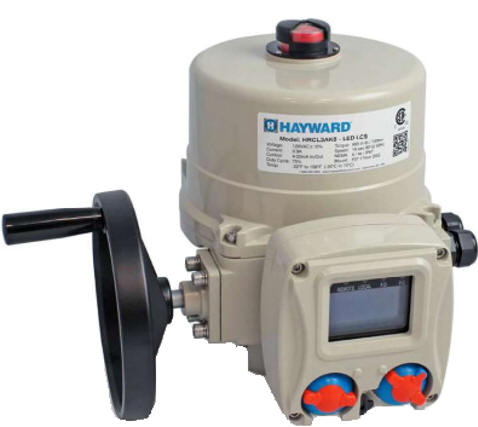Comparison of Electric and Pneumatic Valve Actuators
Need help choosing an actuator? Call us at 908.362.9981 for immediate assistance
Often the decision to use either electric or pneumatic valve actuators is dictated by the resources available or specific characteristics of the application. With this article we provide a comparison of sizes, torque output and features to assist with choosing the most suitable type for your application.
Cycle Time
Pneumatic valve actuators cycle much quicker than electric actuators, which can be beneficial or problematic. Applications requiring a high frequency of actuations definitely benefit from pneumatic actuators. Mechanically the solenoid feeding the compressed air delivers instant torque sufficient for actuation whereas electrical actuators have an electric motor which needs to overcome the resistance to actuation. Smaller size ball valves might require 2-3 seconds for actuation and larger sizes 60-90 seconds; this compares to pneumatic actuation of under 1 second except for the largest size valves where it could take as long as 30 seconds.
 Related
to cycle time is duty cycle and this is only applicable to electrical
actuators. Duty cycle represents the amount of rest time required between
actuations. Rest time is required to enable the actuator motor to cool. The
lower-end electric actuators and sizes used for larger valves might have a
25% duty cycle (requires 45 seconds of “rest” for every 15 seconds of use).
Industrial-duty electric valve actuators often have a 75% duty cycle, so
they only require 15 seconds of rest for every 45 seconds of use. Longer
duty cycles are usually associated with slower cycle times.
Related
to cycle time is duty cycle and this is only applicable to electrical
actuators. Duty cycle represents the amount of rest time required between
actuations. Rest time is required to enable the actuator motor to cool. The
lower-end electric actuators and sizes used for larger valves might have a
25% duty cycle (requires 45 seconds of “rest” for every 15 seconds of use).
Industrial-duty electric valve actuators often have a 75% duty cycle, so
they only require 15 seconds of rest for every 45 seconds of use. Longer
duty cycles are usually associated with slower cycle times.
Mathematically if you have a cycle time of 10 seconds you could cycle an electric actuator with 75% duty cycle about 4.5 times per minute. This is reduced if the environment is especially hot and humid, thus requiring more time for sufficient cooling. If the actuator gets too hot it will shut down via built-in thermal overload until it cools sufficiently.
Duty cycle doesn’t apply to pneumatic actuators and they tend to perform well in hot or humid environments too. However, having a quick acting valve can contribute to water hammer due to the sudden change in liquid velocity. Piping systems need to be designed to accommodate fast acting valves (i.e., reduced velocity, pulsation dampeners) to avoid damaging piping and system components from high pressure spikes. Pneumatic actuators can be modified to reduce the cycle time (slowed) for an additional cost.
Compressed Air vs. Electricity
Pneumatic valve actuators require clean and dry compressed air. Condensate, tramp compressor oil and pipe scale can all contribute to actuator wear or failure. An extremely cold environment could cause condensation in the air lines; pneumatic actuators perform well in warm environments, electric actuators might be a better choice when installed in cold environments. Electric actuators usually have internal heaters designed to prevent condensate from forming and shorting the circuits.
Ensuring quality compressed air involves using gas/liquid separators, drain traps, filters and possibly desiccant filters as part of your compressor system – they’ll need to be maintained to protect your actuators.
Air compressors are not very efficient, the best ones are only 92% efficient and many fall within the 50-80% range; it is easy to ascertain that from an energy efficiency standpoint electric actuators are significantly more efficient. If you are operating only 1 valve and have compressed air already, no big deal. If you have 100 actuators it requires a significant increase in energy and system complexity to use pneumatic valve actuators.

Breadth of Application
Larger valves and higher pressures require increased actuation torque to rotate the valve stem. Your typical ½” to 6” ball valve will likely only require 150-400 in-lbs of torque. Electric actuators will max-out at around 45,000 in-lbs compared to over 1,500,000 in-lbs for huge pneumatic valve actuators. The largest valves will be pneumatically actuated and cycle more than twice as fast.
Hazardous Duty
If explosions are a concern due to the application liquid and environment, pneumatic actuators are a good choice as long as the solenoid valve is also explosion-proof rated or located remotely from the actuator itself. Electric actuators for explosion-proof applications have a NEMA 7 rating and are capable of withstanding pressure from internal explosions.
Position Control
Pneumatic and electric valve actuators can be modified to provide position control. The position of the valve can be controlled for pneumatic actuators using compressed air or an electric/pneumatic positioner accepting a 4-20mA input. Position indicators and transmitters can also be added for precise control.
An electric actuator can be provided with proportional control from a range of input voltages (12VAC-230VAC, 12VDC-12VDC) in conjunction with feedback potentiometers and position relays.
Fail Safe
Pneumatic and electric actuators can be supplied with a spring return to ensure that during an upset condition resulting in a loss of power/compressed air, the valve will fail open or closed. There are not as many options for electrical actuators with spring return and they are quite expensive compared to pneumatic actuators with spring return. A more common fail-safe approach for electric actuators is using a design with an integral battery backup to manage the charge and discharge cycles as well as providing power in the event of main power failure. The lithium-ion battery and supercapacitor bank used in this type of actuator are field replaceable with the power reserve level indicated locally and capable of being monitored remotely.
Cost
Pneumatic valve actuators will cost less and have a longer service life compared to electric valve actuators. This is because pneumatic actuators are simple mechanical devices and when used in conjunction with clean, dry compressed air, will provide very reliable service. Pneumatic valve actuators are about ½ the cost of an electric valve actuator for simple on/off service, although running compressed air to the actuator and controlling the solenoids that send and unload it add to the installation and integration complexity.
 Electric
valve actuators have more built-in features and wiring may be easier to
integrate into a larger control system. We do offer actuators which are
locally controlled, which means they have a built-in control panel. User
interface ranges from basic knob-style control to LCD screens with push
button controls. They are designed to operate the actuator when there is no
PLC or BAS based analog controller, however they also have the ability to
operate with existing control systems. Thus, you can dial-in a proportional
opening right from the valve and/or from an external control system.
Electric valve actuators provide significant flexibility in a compact size,
becoming the economical choice for critical control and monitoring
applications.
Electric
valve actuators have more built-in features and wiring may be easier to
integrate into a larger control system. We do offer actuators which are
locally controlled, which means they have a built-in control panel. User
interface ranges from basic knob-style control to LCD screens with push
button controls. They are designed to operate the actuator when there is no
PLC or BAS based analog controller, however they also have the ability to
operate with existing control systems. Thus, you can dial-in a proportional
opening right from the valve and/or from an external control system.
Electric valve actuators provide significant flexibility in a compact size,
becoming the economical choice for critical control and monitoring
applications.
Reviewing your application with a knowledgeable actuator and valve specialist helps to ensure the most appropriate actuator is chosen for your specific application. We look at overall size, cost, functionality as relates to duty cycle and cycle time, as well as materials of construction, availability and most importantly how they’ll interface with the valve being controlled. When actuated valves are purchased as an assembly, they are factory assembled and tested; we help make sure the valve and actuator are a good “match”. When supplying an actuator for an existing valve we also need to ensure it will mount properly and has sufficient torque for your valve/application.
Please keep us in-mind the next time you have an actuated valve application and let us put our experience to work for you!




